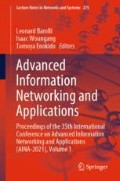Abstract
Contact tracing is a method of identifying people who may have come into contact with an infected person during a virus incubation time. Standard contact tracing is performed to identify only the first level of exposures, whereas in reality, exposures can occur across multiple levels. Multi-level contact tracing can reveal a wider range of objects which contribute to the spread of the virus. This paper proposes a k-Level Contact Tracing Query (kL-CTQ) to reveal a broader range of objects which have possibly been exposed to pathogens. To minimize manual location tracing while preserving the user’s privacy, we propose a mesh block sequence (MBS) method where the trajectories are transformed into an MBS before being shared with health authorities. While our simulation uses an Australian administrative region structure, this method is applicable in countries which implement similar administrative hierarchical building blocks.
Access this chapter
Tax calculation will be finalised at checkout
Purchases are for personal use only
References
Adhinugraha, K., Rahayu, W., Hara, T., Taniar, D.: Contact Tracing with Mesh Block-based Trajectories. ACM Trans. Spat. Algorithms Syst. (submitted) (2020)
Adhinugraha, K., Rahayu, W., Hara, T., Taniar, D.: Dealing with noise in crowdsourced GPS human trajectory logging data. In: Concurrency Computation, September, pp. 1–18 (2020). https://doi.org/10.1002/cpe.6139
Alamri, S., Taniar, D., Safar, M.: A taxonomy for moving object queries in spatial databases. Future Gener. Comput. Syst. 37, 232–242 (2014). https://doi.org/10.1016/j.future.2014.02.007. http://dx.doi.org/10.1016/j.future.2014.02.007
Australia, D.O.H.: COVIDSafe. https://www.health.gov.au/resources/apps-and-tools/covidsafe-app
Goh, J., Taniar, D.: Mining frequency pattern from mobile users. Lecture Notes in Computer Science (including subseries Lecture Notes in Artificial Intelligence and Lecture Notes in Bioinformatics), vol. 3215, 795–801 (2004). https://doi.org/10.1007/978-3-540-30134-9_106
Goh, J.Y., Taniar, D.: Mobile data mining by location dependencies. Lecture Notes in Computer Science (including subseries Lecture Notes in Artificial Intelligence and Lecture Notes in Bioinformatics), vol. 3177, 225–231 (2004). https://doi.org/10.1007/978-3-540-28651-6_33
Hellewell, J., Abbott, S., Gimma, A., Bosse, N.I., Jarvis, C.I., Russell, T.W., Munday, J.D., Kucharski, A.J., Edmunds, W.J., Sun, F., Flasche, S., Quilty, B.J., Davies, N., Liu, Y., Clifford, S., Klepac, P., Jit, M., Diamond, C., Gibbs, H., van Zandvoort, K., Funk, S., Eggo, R.M.: Feasibility of controlling COVID-19 outbreaks by isolation of cases and contacts. Lancet Global Health 8(4), e488–e496 (2020). https://doi.org/10.1016/S2214-109X(20)30074-7
Kim, W., Lee, H., Chung, Y.D.: Safe contact tracing for COVID-19: a method without privacy breach using functional encryption techniques based-on spatio-temporal trajectory data, pp. 1–16 (2020). https://doi.org/10.1101/2020.06.29.20143180
Li, X.Y., Jung, T.: Search me if you can: privacy-preserving location query service. In: Proceedings - IEEE INFOCOM, pp. 2760–2768 (2013). https://doi.org/10.1109/INFCOM.2013.6567085
Liao, D., Li, H., Sun, G., Anand, V.: Protecting user trajectory in location-based services. In: 2015 IEEE Global Communications Conference, GLOBECOM 2015 (2015). https://doi.org/10.1109/GLOCOM.2014.7417512
Marcel, S., Christian, A.L., Richard, N., Silvia, S., Emma, H., Jacques, F., Marcel, Z., Gabriela, S., Manuel, B., Annelies, W.S., Isabella, E., Matthias, E., Nicola, L.: COVID-19 epidemic in Switzerland: on the importance of testing, contact tracing and isolation. Swiss Med. Wkly. 150(11–12), 4–6 (2020). https://doi.org/10.4414/smw.2020.20225
Mariescu-Istodor, R., Fränti, P.: Grid-based method for GPS route analysis for retrieval. ACM Trans. Spat. Algorithms Syst. 3(3), 1–28 (2017). https://doi.org/10.1145/3125634
Meixner, S.: How many people have downloaded the COVIDSafe app and how central has it been to Australia’s coronavirus response? (2020). https://www.abc.net.au/news/2020-06-02/coronavirus-covid19-covidsafe-app-how-many-downloads-greg-hunt/12295130
PEPP-PT: Pan-European Privacy-Preserving Proximity Tracing (2020). https://www.pepp-pt.org, https://github.com/pepp-pt/pepp-pt-documentation/blob/master/PEPP-PT-high-level-overview.pdf
Pietrzak, K.: Delayed Authentication Replay and Relay Attacks on DP-3T, pp. 1–6 (2020). https://eprint.iacr.org/2020/418.pdf
Raskar, R.M.: Private Kit: Safe Paths; Privacy-by-Design (2020). https://safepaths.mit.edu/
Reichert, L., Brack, S., Scheuermann, B.: Privacy-Preserving Contact Tracing of COVID-19 Patients. IACR Cryptol, pp. 4–5 (2020). http://arxiv.org/abs/2004.06818, https://eprint.iacr.org/2020/375.pdf
Shao, Z., Taniar, D., Adhinugraha, K.M.: Range-kNN queries with privacy protection in a mobile environment. Pervasive Mob. Comput. 24, 30–49 (2015). https://doi.org/10.1016/j.pmcj.2015.05.004
Taniar, D., Goh, J.: On mining movement pattern from mobile users. Int. J. Distrib. Sens. Netw. 3(1), 69–86 (2007). https://doi.org/10.1080/15501320601069499
Thomas, S.A., Gharge, S.: Enhanced security for military grid reference system using visual cryptography. In: 2018 9th International Conference on Computing, Communication and Networking Technologies, ICCCNT 2018 (2018). https://doi.org/10.1109/ICCCNT.2018.8494139
Waluyo, A.B., Srinivasan, B., Taniar, D.: Research on location-dependent queries in mobile databases. Comput. Syst. Sci. Eng. 20(2), 79–95 (2005)
Xu, F., Huang, Z., Dai, H., Zhu, X., Wu, H., Zhang, J.: A real-time traffic index model for expressways. Concurrency Comput. 31(24), 1–20 (2019). https://doi.org/10.1002/cpe.5155
Zhang, L., Cai, Z., Wang, X.: FakeMask: a novel privacy preserving approach for smartphones. IEEE Trans. Netw. Serv. Manage. 13(2), 335–348 (2016). https://doi.org/10.1109/TNSM.2016.2559448
Author information
Authors and Affiliations
Corresponding author
Editor information
Editors and Affiliations
Rights and permissions
Copyright information
© 2021 The Author(s), under exclusive license to Springer Nature Switzerland AG
About this paper
Cite this paper
Adhinugraha, K., Rahayu, W., Taniar, D. (2021). k-Level Contact Tracing Using Mesh Block-Based Trajectories for Infectious Diseases. In: Barolli, L., Woungang, I., Enokido, T. (eds) Advanced Information Networking and Applications. AINA 2021. Lecture Notes in Networks and Systems, vol 225. Springer, Cham. https://doi.org/10.1007/978-3-030-75100-5_24
Download citation
DOI: https://doi.org/10.1007/978-3-030-75100-5_24
Published:
Publisher Name: Springer, Cham
Print ISBN: 978-3-030-75099-2
Online ISBN: 978-3-030-75100-5
eBook Packages: Intelligent Technologies and RoboticsIntelligent Technologies and Robotics (R0)

